Analysis of Social Media Articles: Literature Critique and Comparison
VerifiedAdded on 2022/08/25
|8
|1939
|22
Essay
AI Summary
This essay critically analyzes three academic articles that explore the multifaceted relationship between social media and activism. The first article examines the role of social media in Turkish feminism, analyzing its impact on women's activism. The second article investigates how social media functions as a tool for campus sexual violence activism, focusing on strategies employed by activists. The third article focuses on youth activism and social media tactics under repression in Cambodia. The essay compares and contrasts the literature reviews, methodologies (including semi-structured interviews and ethnographic studies), and findings of each article, highlighting their strengths and weaknesses. The analysis reveals how social media platforms facilitate activism, build communities, and influence power dynamics, while also acknowledging the challenges of repression and the need for nuanced approaches. The essay concludes by assessing the overall effectiveness of each research paper, emphasizing the importance of strong methodologies and contextual understanding in studying social media's impact on activism.
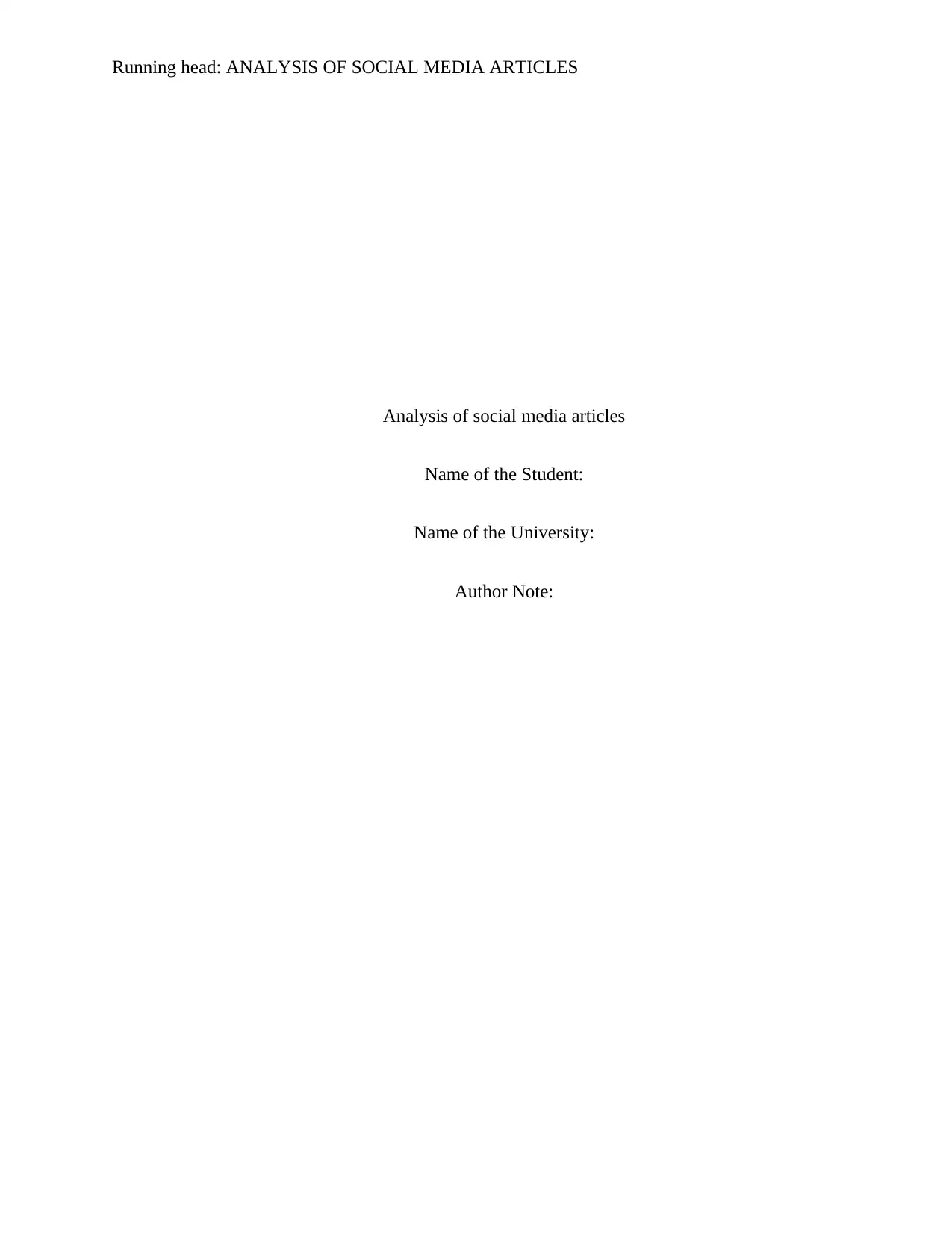
Running head: ANALYSIS OF SOCIAL MEDIA ARTICLES
Analysis of social media articles
Name of the Student:
Name of the University:
Author Note:
Analysis of social media articles
Name of the Student:
Name of the University:
Author Note:
Paraphrase This Document
Need a fresh take? Get an instant paraphrase of this document with our AI Paraphraser
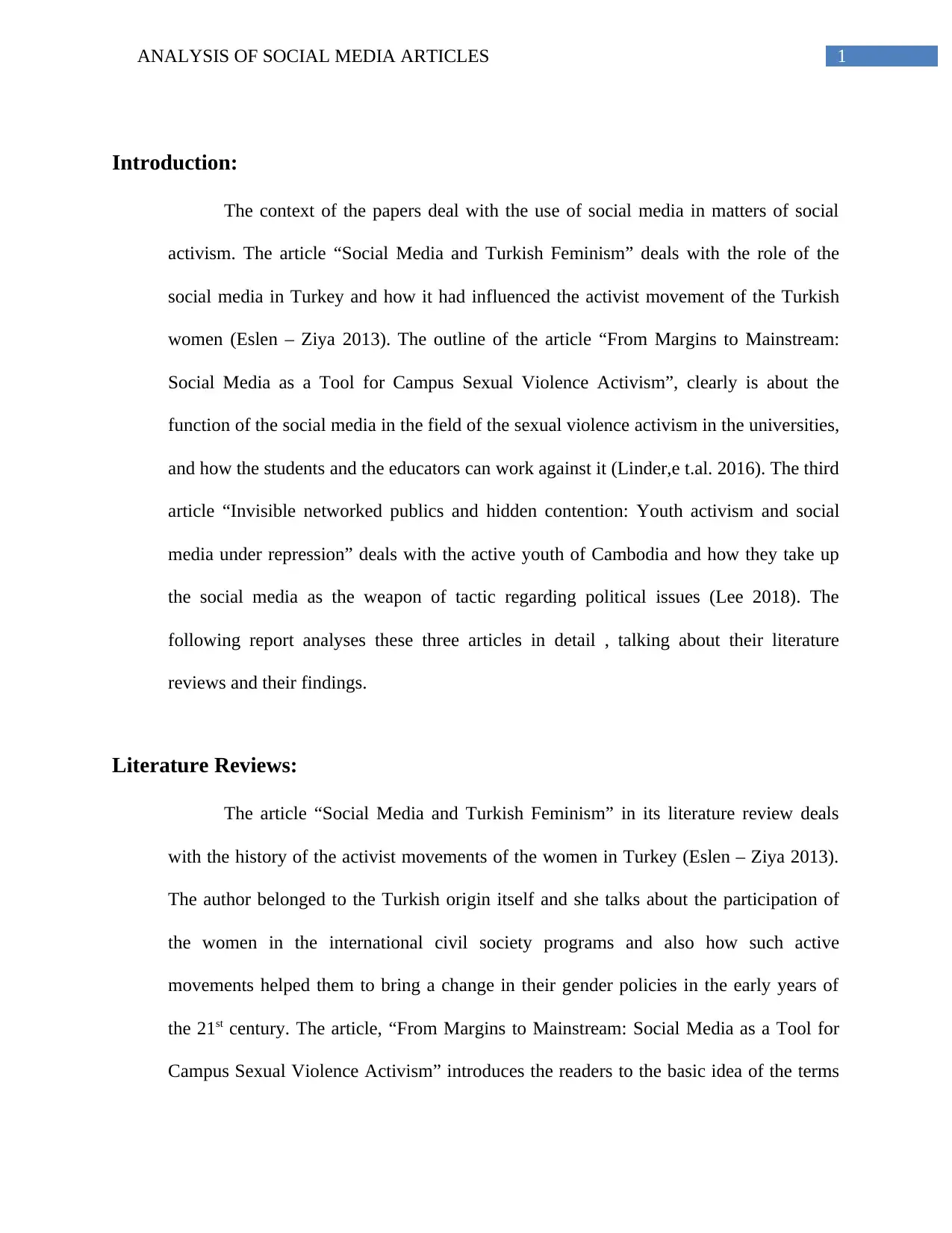
1ANALYSIS OF SOCIAL MEDIA ARTICLES
Introduction:
The context of the papers deal with the use of social media in matters of social
activism. The article “Social Media and Turkish Feminism” deals with the role of the
social media in Turkey and how it had influenced the activist movement of the Turkish
women (Eslen – Ziya 2013). The outline of the article “From Margins to Mainstream:
Social Media as a Tool for Campus Sexual Violence Activism”, clearly is about the
function of the social media in the field of the sexual violence activism in the universities,
and how the students and the educators can work against it (Linder,e t.al. 2016). The third
article “Invisible networked publics and hidden contention: Youth activism and social
media under repression” deals with the active youth of Cambodia and how they take up
the social media as the weapon of tactic regarding political issues (Lee 2018). The
following report analyses these three articles in detail , talking about their literature
reviews and their findings.
Literature Reviews:
The article “Social Media and Turkish Feminism” in its literature review deals
with the history of the activist movements of the women in Turkey (Eslen – Ziya 2013).
The author belonged to the Turkish origin itself and she talks about the participation of
the women in the international civil society programs and also how such active
movements helped them to bring a change in their gender policies in the early years of
the 21st century. The article, “From Margins to Mainstream: Social Media as a Tool for
Campus Sexual Violence Activism” introduces the readers to the basic idea of the terms
Introduction:
The context of the papers deal with the use of social media in matters of social
activism. The article “Social Media and Turkish Feminism” deals with the role of the
social media in Turkey and how it had influenced the activist movement of the Turkish
women (Eslen – Ziya 2013). The outline of the article “From Margins to Mainstream:
Social Media as a Tool for Campus Sexual Violence Activism”, clearly is about the
function of the social media in the field of the sexual violence activism in the universities,
and how the students and the educators can work against it (Linder,e t.al. 2016). The third
article “Invisible networked publics and hidden contention: Youth activism and social
media under repression” deals with the active youth of Cambodia and how they take up
the social media as the weapon of tactic regarding political issues (Lee 2018). The
following report analyses these three articles in detail , talking about their literature
reviews and their findings.
Literature Reviews:
The article “Social Media and Turkish Feminism” in its literature review deals
with the history of the activist movements of the women in Turkey (Eslen – Ziya 2013).
The author belonged to the Turkish origin itself and she talks about the participation of
the women in the international civil society programs and also how such active
movements helped them to bring a change in their gender policies in the early years of
the 21st century. The article, “From Margins to Mainstream: Social Media as a Tool for
Campus Sexual Violence Activism” introduces the readers to the basic idea of the terms
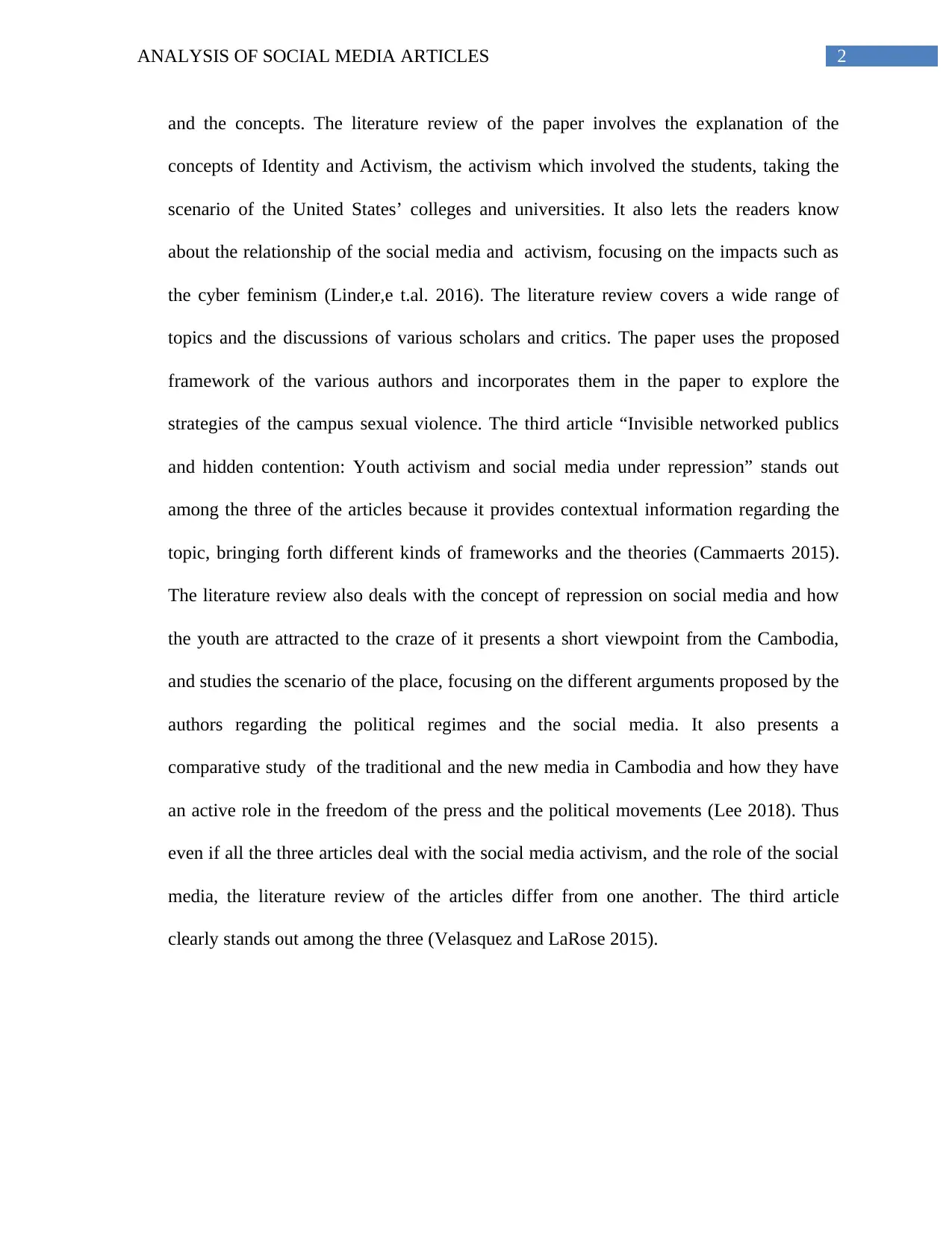
2ANALYSIS OF SOCIAL MEDIA ARTICLES
and the concepts. The literature review of the paper involves the explanation of the
concepts of Identity and Activism, the activism which involved the students, taking the
scenario of the United States’ colleges and universities. It also lets the readers know
about the relationship of the social media and activism, focusing on the impacts such as
the cyber feminism (Linder,e t.al. 2016). The literature review covers a wide range of
topics and the discussions of various scholars and critics. The paper uses the proposed
framework of the various authors and incorporates them in the paper to explore the
strategies of the campus sexual violence. The third article “Invisible networked publics
and hidden contention: Youth activism and social media under repression” stands out
among the three of the articles because it provides contextual information regarding the
topic, bringing forth different kinds of frameworks and the theories (Cammaerts 2015).
The literature review also deals with the concept of repression on social media and how
the youth are attracted to the craze of it presents a short viewpoint from the Cambodia,
and studies the scenario of the place, focusing on the different arguments proposed by the
authors regarding the political regimes and the social media. It also presents a
comparative study of the traditional and the new media in Cambodia and how they have
an active role in the freedom of the press and the political movements (Lee 2018). Thus
even if all the three articles deal with the social media activism, and the role of the social
media, the literature review of the articles differ from one another. The third article
clearly stands out among the three (Velasquez and LaRose 2015).
and the concepts. The literature review of the paper involves the explanation of the
concepts of Identity and Activism, the activism which involved the students, taking the
scenario of the United States’ colleges and universities. It also lets the readers know
about the relationship of the social media and activism, focusing on the impacts such as
the cyber feminism (Linder,e t.al. 2016). The literature review covers a wide range of
topics and the discussions of various scholars and critics. The paper uses the proposed
framework of the various authors and incorporates them in the paper to explore the
strategies of the campus sexual violence. The third article “Invisible networked publics
and hidden contention: Youth activism and social media under repression” stands out
among the three of the articles because it provides contextual information regarding the
topic, bringing forth different kinds of frameworks and the theories (Cammaerts 2015).
The literature review also deals with the concept of repression on social media and how
the youth are attracted to the craze of it presents a short viewpoint from the Cambodia,
and studies the scenario of the place, focusing on the different arguments proposed by the
authors regarding the political regimes and the social media. It also presents a
comparative study of the traditional and the new media in Cambodia and how they have
an active role in the freedom of the press and the political movements (Lee 2018). Thus
even if all the three articles deal with the social media activism, and the role of the social
media, the literature review of the articles differ from one another. The third article
clearly stands out among the three (Velasquez and LaRose 2015).
⊘ This is a preview!⊘
Do you want full access?
Subscribe today to unlock all pages.

Trusted by 1+ million students worldwide
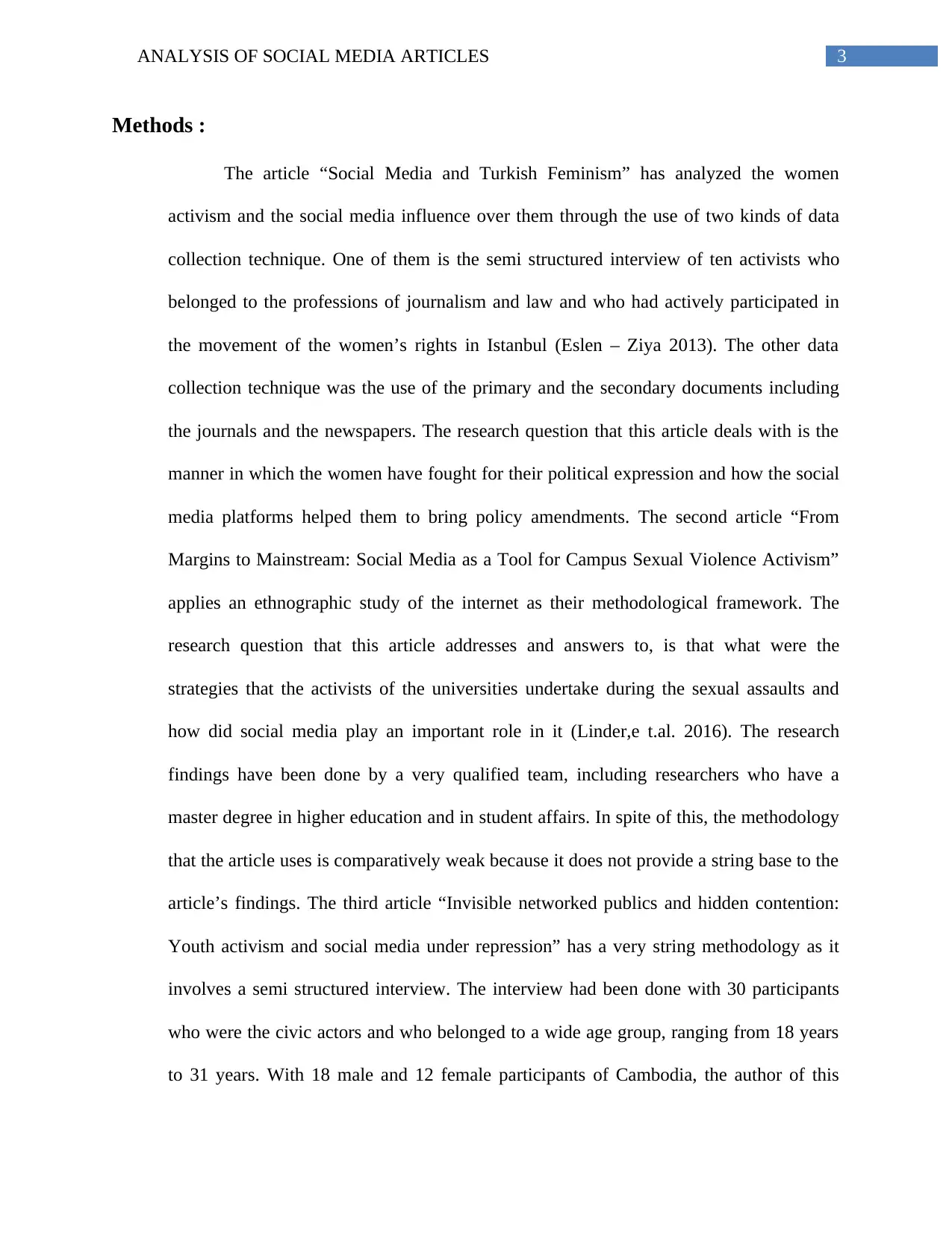
3ANALYSIS OF SOCIAL MEDIA ARTICLES
Methods :
The article “Social Media and Turkish Feminism” has analyzed the women
activism and the social media influence over them through the use of two kinds of data
collection technique. One of them is the semi structured interview of ten activists who
belonged to the professions of journalism and law and who had actively participated in
the movement of the women’s rights in Istanbul (Eslen – Ziya 2013). The other data
collection technique was the use of the primary and the secondary documents including
the journals and the newspapers. The research question that this article deals with is the
manner in which the women have fought for their political expression and how the social
media platforms helped them to bring policy amendments. The second article “From
Margins to Mainstream: Social Media as a Tool for Campus Sexual Violence Activism”
applies an ethnographic study of the internet as their methodological framework. The
research question that this article addresses and answers to, is that what were the
strategies that the activists of the universities undertake during the sexual assaults and
how did social media play an important role in it (Linder,e t.al. 2016). The research
findings have been done by a very qualified team, including researchers who have a
master degree in higher education and in student affairs. In spite of this, the methodology
that the article uses is comparatively weak because it does not provide a string base to the
article’s findings. The third article “Invisible networked publics and hidden contention:
Youth activism and social media under repression” has a very string methodology as it
involves a semi structured interview. The interview had been done with 30 participants
who were the civic actors and who belonged to a wide age group, ranging from 18 years
to 31 years. With 18 male and 12 female participants of Cambodia, the author of this
Methods :
The article “Social Media and Turkish Feminism” has analyzed the women
activism and the social media influence over them through the use of two kinds of data
collection technique. One of them is the semi structured interview of ten activists who
belonged to the professions of journalism and law and who had actively participated in
the movement of the women’s rights in Istanbul (Eslen – Ziya 2013). The other data
collection technique was the use of the primary and the secondary documents including
the journals and the newspapers. The research question that this article deals with is the
manner in which the women have fought for their political expression and how the social
media platforms helped them to bring policy amendments. The second article “From
Margins to Mainstream: Social Media as a Tool for Campus Sexual Violence Activism”
applies an ethnographic study of the internet as their methodological framework. The
research question that this article addresses and answers to, is that what were the
strategies that the activists of the universities undertake during the sexual assaults and
how did social media play an important role in it (Linder,e t.al. 2016). The research
findings have been done by a very qualified team, including researchers who have a
master degree in higher education and in student affairs. In spite of this, the methodology
that the article uses is comparatively weak because it does not provide a string base to the
article’s findings. The third article “Invisible networked publics and hidden contention:
Youth activism and social media under repression” has a very string methodology as it
involves a semi structured interview. The interview had been done with 30 participants
who were the civic actors and who belonged to a wide age group, ranging from 18 years
to 31 years. With 18 male and 12 female participants of Cambodia, the author of this
Paraphrase This Document
Need a fresh take? Get an instant paraphrase of this document with our AI Paraphraser
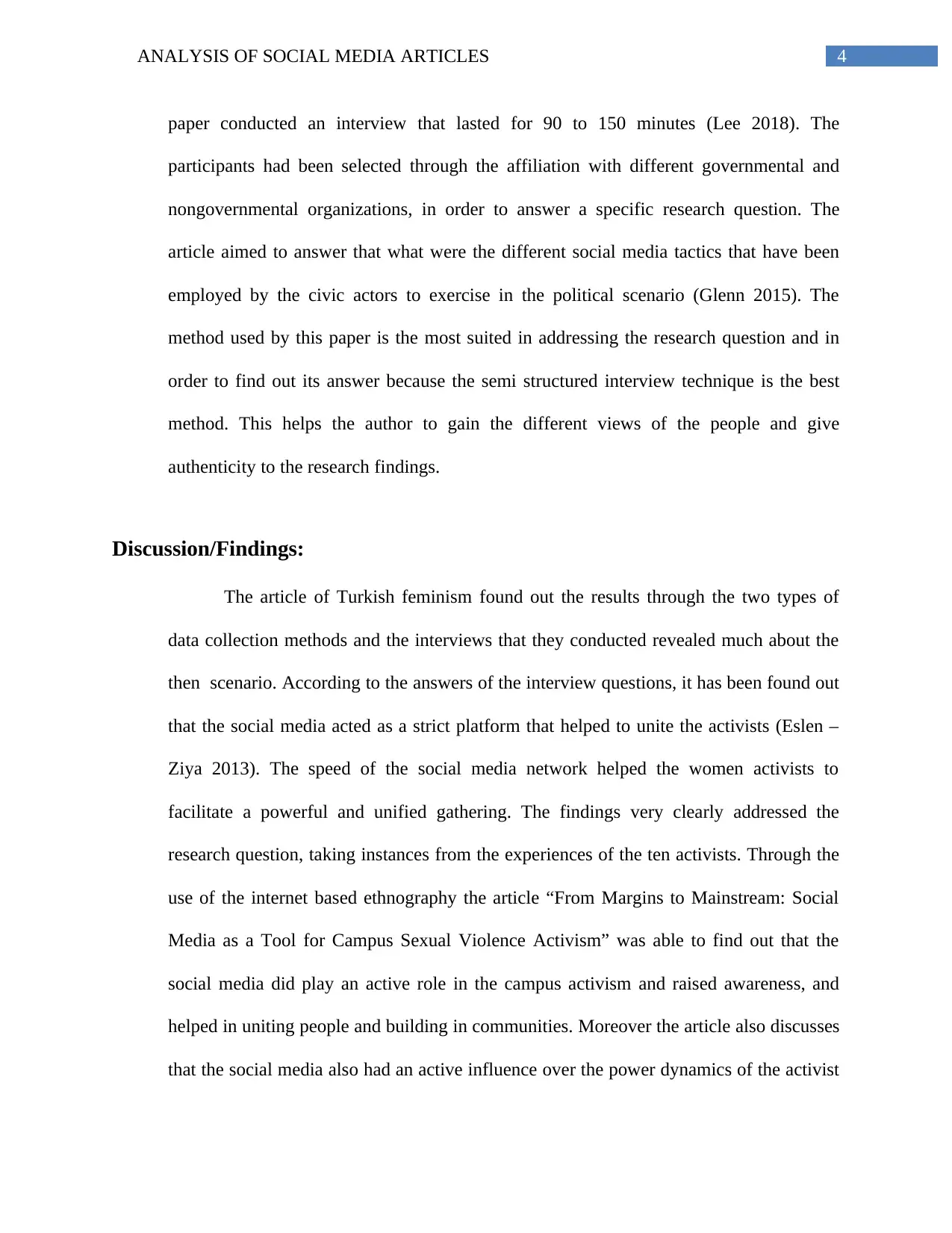
4ANALYSIS OF SOCIAL MEDIA ARTICLES
paper conducted an interview that lasted for 90 to 150 minutes (Lee 2018). The
participants had been selected through the affiliation with different governmental and
nongovernmental organizations, in order to answer a specific research question. The
article aimed to answer that what were the different social media tactics that have been
employed by the civic actors to exercise in the political scenario (Glenn 2015). The
method used by this paper is the most suited in addressing the research question and in
order to find out its answer because the semi structured interview technique is the best
method. This helps the author to gain the different views of the people and give
authenticity to the research findings.
Discussion/Findings:
The article of Turkish feminism found out the results through the two types of
data collection methods and the interviews that they conducted revealed much about the
then scenario. According to the answers of the interview questions, it has been found out
that the social media acted as a strict platform that helped to unite the activists (Eslen –
Ziya 2013). The speed of the social media network helped the women activists to
facilitate a powerful and unified gathering. The findings very clearly addressed the
research question, taking instances from the experiences of the ten activists. Through the
use of the internet based ethnography the article “From Margins to Mainstream: Social
Media as a Tool for Campus Sexual Violence Activism” was able to find out that the
social media did play an active role in the campus activism and raised awareness, and
helped in uniting people and building in communities. Moreover the article also discusses
that the social media also had an active influence over the power dynamics of the activist
paper conducted an interview that lasted for 90 to 150 minutes (Lee 2018). The
participants had been selected through the affiliation with different governmental and
nongovernmental organizations, in order to answer a specific research question. The
article aimed to answer that what were the different social media tactics that have been
employed by the civic actors to exercise in the political scenario (Glenn 2015). The
method used by this paper is the most suited in addressing the research question and in
order to find out its answer because the semi structured interview technique is the best
method. This helps the author to gain the different views of the people and give
authenticity to the research findings.
Discussion/Findings:
The article of Turkish feminism found out the results through the two types of
data collection methods and the interviews that they conducted revealed much about the
then scenario. According to the answers of the interview questions, it has been found out
that the social media acted as a strict platform that helped to unite the activists (Eslen –
Ziya 2013). The speed of the social media network helped the women activists to
facilitate a powerful and unified gathering. The findings very clearly addressed the
research question, taking instances from the experiences of the ten activists. Through the
use of the internet based ethnography the article “From Margins to Mainstream: Social
Media as a Tool for Campus Sexual Violence Activism” was able to find out that the
social media did play an active role in the campus activism and raised awareness, and
helped in uniting people and building in communities. Moreover the article also discusses
that the social media also had an active influence over the power dynamics of the activist
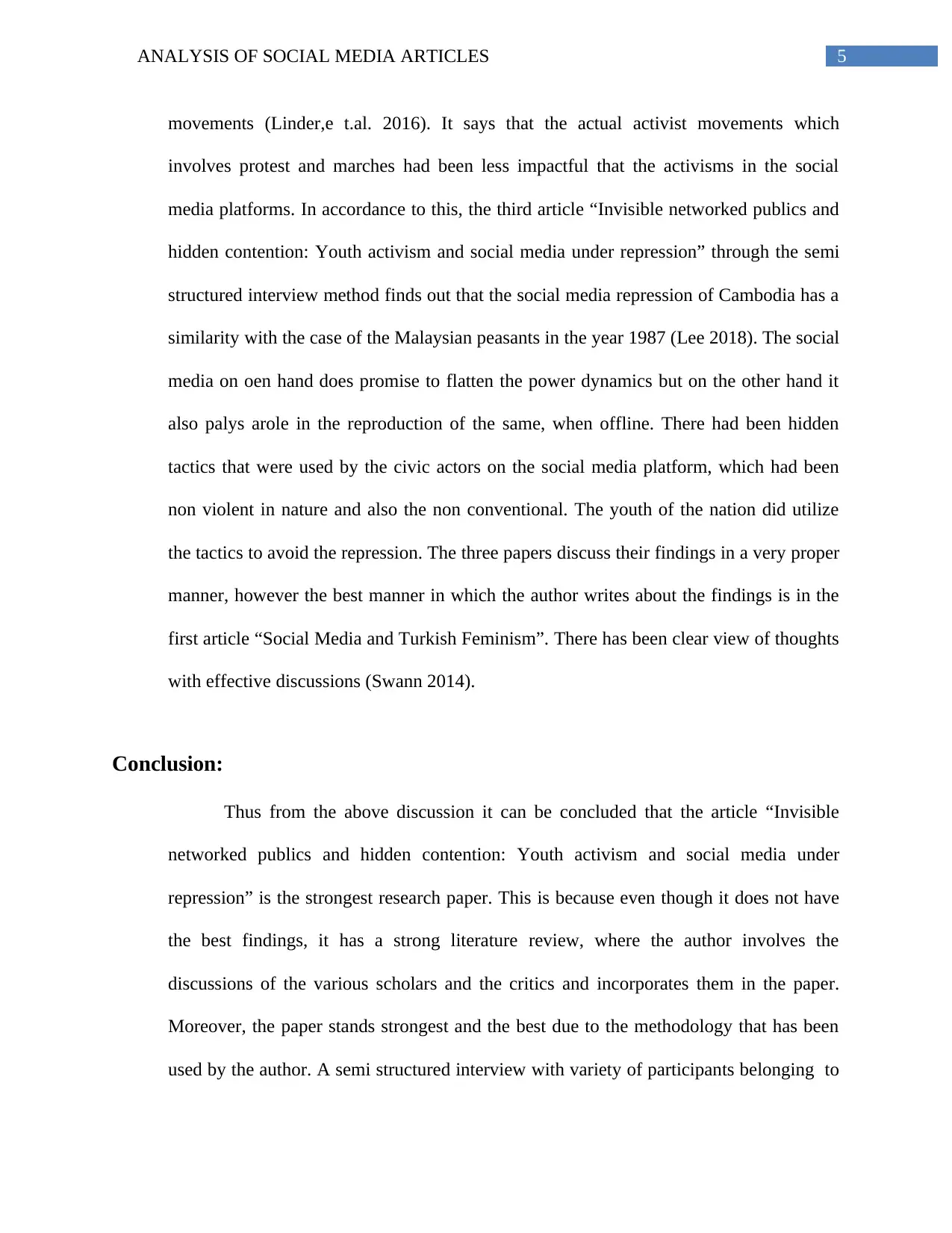
5ANALYSIS OF SOCIAL MEDIA ARTICLES
movements (Linder,e t.al. 2016). It says that the actual activist movements which
involves protest and marches had been less impactful that the activisms in the social
media platforms. In accordance to this, the third article “Invisible networked publics and
hidden contention: Youth activism and social media under repression” through the semi
structured interview method finds out that the social media repression of Cambodia has a
similarity with the case of the Malaysian peasants in the year 1987 (Lee 2018). The social
media on oen hand does promise to flatten the power dynamics but on the other hand it
also palys arole in the reproduction of the same, when offline. There had been hidden
tactics that were used by the civic actors on the social media platform, which had been
non violent in nature and also the non conventional. The youth of the nation did utilize
the tactics to avoid the repression. The three papers discuss their findings in a very proper
manner, however the best manner in which the author writes about the findings is in the
first article “Social Media and Turkish Feminism”. There has been clear view of thoughts
with effective discussions (Swann 2014).
Conclusion:
Thus from the above discussion it can be concluded that the article “Invisible
networked publics and hidden contention: Youth activism and social media under
repression” is the strongest research paper. This is because even though it does not have
the best findings, it has a strong literature review, where the author involves the
discussions of the various scholars and the critics and incorporates them in the paper.
Moreover, the paper stands strongest and the best due to the methodology that has been
used by the author. A semi structured interview with variety of participants belonging to
movements (Linder,e t.al. 2016). It says that the actual activist movements which
involves protest and marches had been less impactful that the activisms in the social
media platforms. In accordance to this, the third article “Invisible networked publics and
hidden contention: Youth activism and social media under repression” through the semi
structured interview method finds out that the social media repression of Cambodia has a
similarity with the case of the Malaysian peasants in the year 1987 (Lee 2018). The social
media on oen hand does promise to flatten the power dynamics but on the other hand it
also palys arole in the reproduction of the same, when offline. There had been hidden
tactics that were used by the civic actors on the social media platform, which had been
non violent in nature and also the non conventional. The youth of the nation did utilize
the tactics to avoid the repression. The three papers discuss their findings in a very proper
manner, however the best manner in which the author writes about the findings is in the
first article “Social Media and Turkish Feminism”. There has been clear view of thoughts
with effective discussions (Swann 2014).
Conclusion:
Thus from the above discussion it can be concluded that the article “Invisible
networked publics and hidden contention: Youth activism and social media under
repression” is the strongest research paper. This is because even though it does not have
the best findings, it has a strong literature review, where the author involves the
discussions of the various scholars and the critics and incorporates them in the paper.
Moreover, the paper stands strongest and the best due to the methodology that has been
used by the author. A semi structured interview with variety of participants belonging to
⊘ This is a preview!⊘
Do you want full access?
Subscribe today to unlock all pages.

Trusted by 1+ million students worldwide
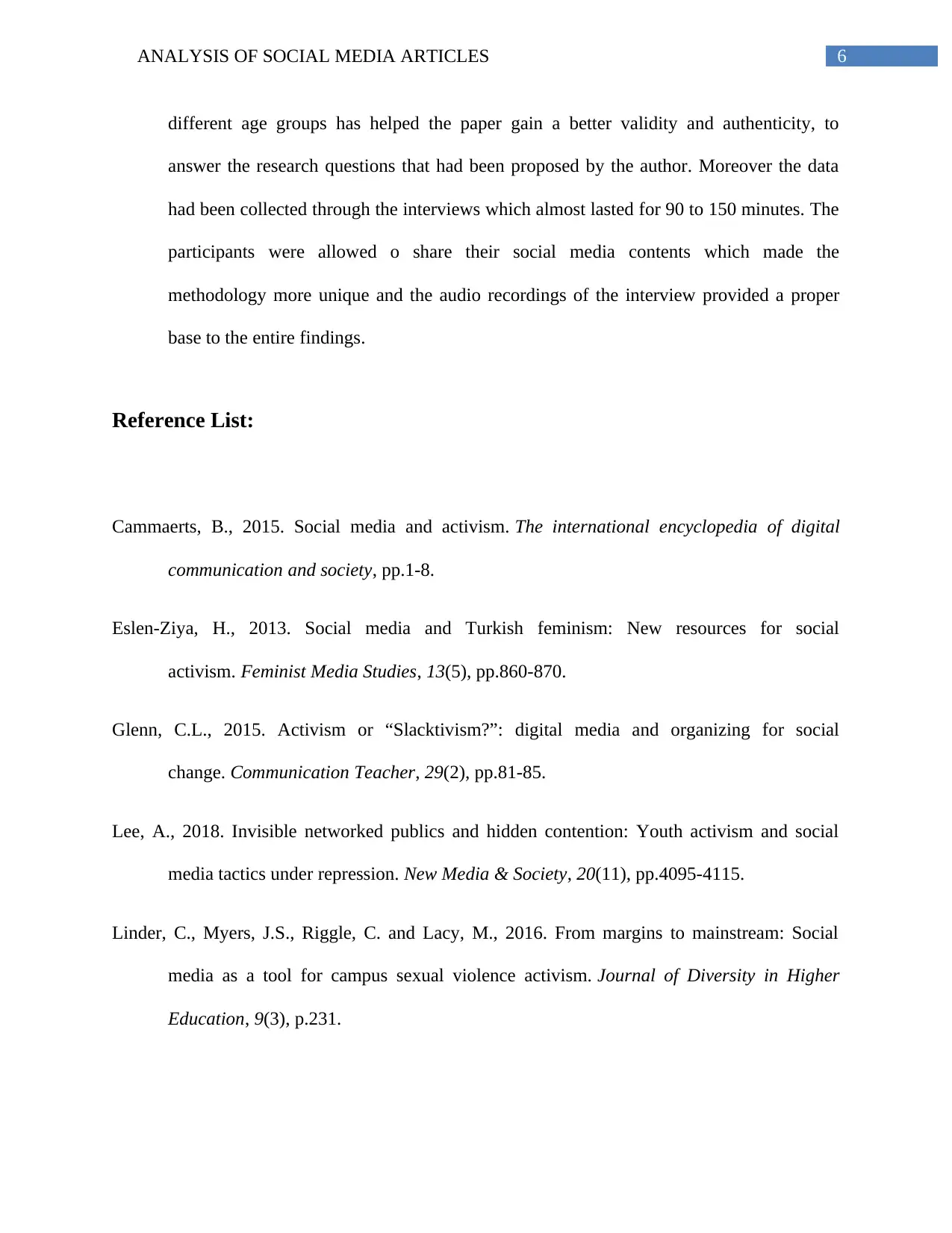
6ANALYSIS OF SOCIAL MEDIA ARTICLES
different age groups has helped the paper gain a better validity and authenticity, to
answer the research questions that had been proposed by the author. Moreover the data
had been collected through the interviews which almost lasted for 90 to 150 minutes. The
participants were allowed o share their social media contents which made the
methodology more unique and the audio recordings of the interview provided a proper
base to the entire findings.
Reference List:
Cammaerts, B., 2015. Social media and activism. The international encyclopedia of digital
communication and society, pp.1-8.
Eslen-Ziya, H., 2013. Social media and Turkish feminism: New resources for social
activism. Feminist Media Studies, 13(5), pp.860-870.
Glenn, C.L., 2015. Activism or “Slacktivism?”: digital media and organizing for social
change. Communication Teacher, 29(2), pp.81-85.
Lee, A., 2018. Invisible networked publics and hidden contention: Youth activism and social
media tactics under repression. New Media & Society, 20(11), pp.4095-4115.
Linder, C., Myers, J.S., Riggle, C. and Lacy, M., 2016. From margins to mainstream: Social
media as a tool for campus sexual violence activism. Journal of Diversity in Higher
Education, 9(3), p.231.
different age groups has helped the paper gain a better validity and authenticity, to
answer the research questions that had been proposed by the author. Moreover the data
had been collected through the interviews which almost lasted for 90 to 150 minutes. The
participants were allowed o share their social media contents which made the
methodology more unique and the audio recordings of the interview provided a proper
base to the entire findings.
Reference List:
Cammaerts, B., 2015. Social media and activism. The international encyclopedia of digital
communication and society, pp.1-8.
Eslen-Ziya, H., 2013. Social media and Turkish feminism: New resources for social
activism. Feminist Media Studies, 13(5), pp.860-870.
Glenn, C.L., 2015. Activism or “Slacktivism?”: digital media and organizing for social
change. Communication Teacher, 29(2), pp.81-85.
Lee, A., 2018. Invisible networked publics and hidden contention: Youth activism and social
media tactics under repression. New Media & Society, 20(11), pp.4095-4115.
Linder, C., Myers, J.S., Riggle, C. and Lacy, M., 2016. From margins to mainstream: Social
media as a tool for campus sexual violence activism. Journal of Diversity in Higher
Education, 9(3), p.231.
Paraphrase This Document
Need a fresh take? Get an instant paraphrase of this document with our AI Paraphraser
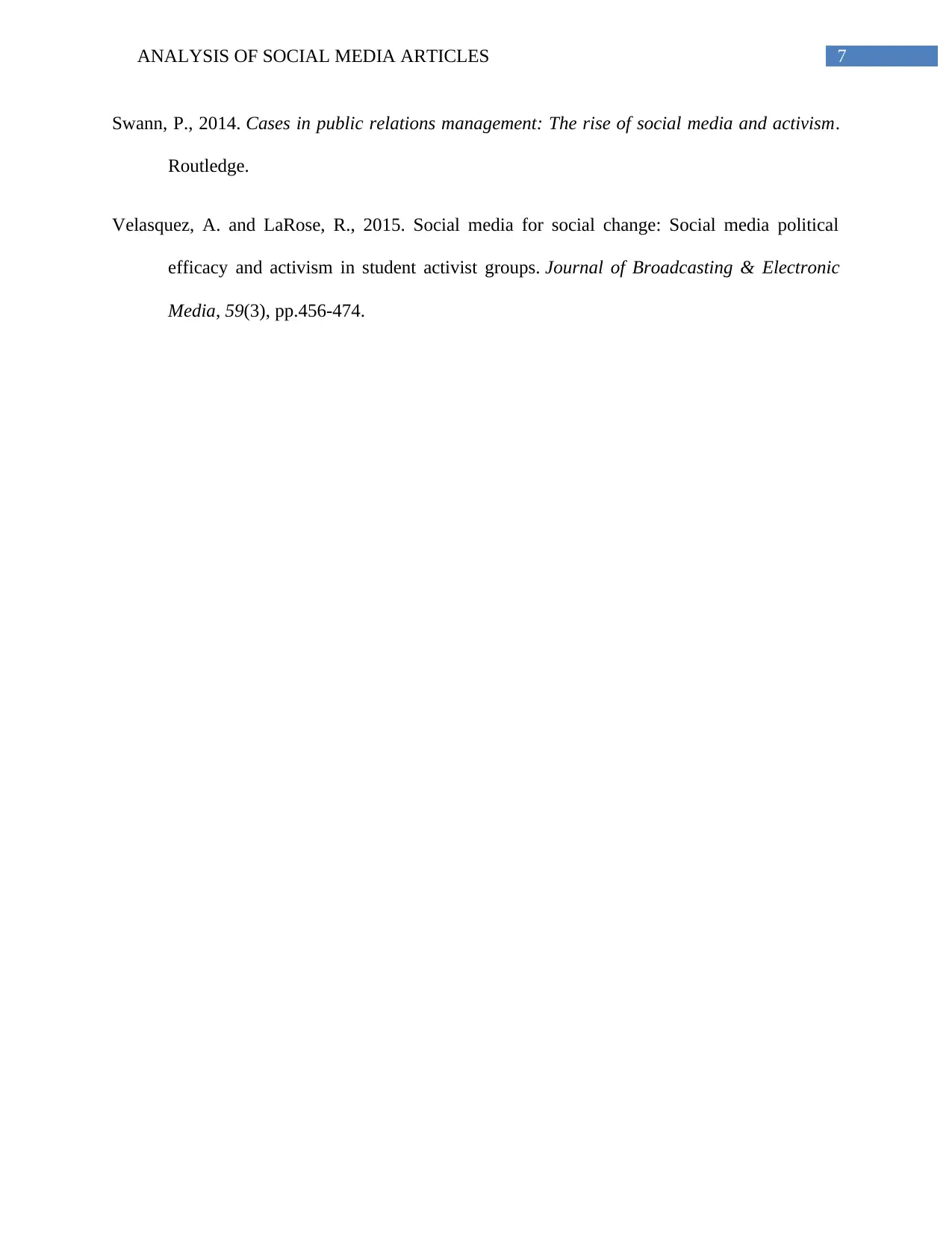
7ANALYSIS OF SOCIAL MEDIA ARTICLES
Swann, P., 2014. Cases in public relations management: The rise of social media and activism.
Routledge.
Velasquez, A. and LaRose, R., 2015. Social media for social change: Social media political
efficacy and activism in student activist groups. Journal of Broadcasting & Electronic
Media, 59(3), pp.456-474.
Swann, P., 2014. Cases in public relations management: The rise of social media and activism.
Routledge.
Velasquez, A. and LaRose, R., 2015. Social media for social change: Social media political
efficacy and activism in student activist groups. Journal of Broadcasting & Electronic
Media, 59(3), pp.456-474.
1 out of 8
Your All-in-One AI-Powered Toolkit for Academic Success.
+13062052269
info@desklib.com
Available 24*7 on WhatsApp / Email
![[object Object]](/_next/static/media/star-bottom.7253800d.svg)
Unlock your academic potential
Copyright © 2020–2025 A2Z Services. All Rights Reserved. Developed and managed by ZUCOL.